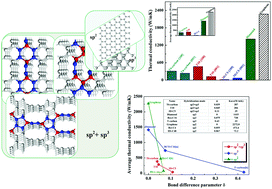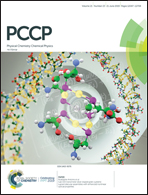High bond difference parameter-induced low thermal transmission in carbon allotropes with sp2 and sp3 hybridization†
Abstract
Carbon allotropes play an important role in the thermal transmission field, while there are huge thermal differences in their thermal conductivities. In this work, thermal transmission in three novel carbon allotropes with sp2 and sp3 hybridization has been studied, including T6-carbon, T10 and 3D-C5 by using non-equilibrium molecular dynamic simulations and phonon kinetic theory. Graphene and diamond with standard sp2 and sp3 hybridization, respectively, are also examined for comparison. Our results indicate that the thermal conductivities of T6-carbon, T10 and 3D-C5 at room temperature are much lower than those of diamond and graphene. Phonon kinetic theory analysis shows that the lower thermal conductivity of T6-carbon, T10 and 3D-C5 is caused by the combined action of their reduced phonon group velocities and relaxation time. Moreover, the bond difference parameter has been proposed to describe the relationship between bond structures and thermal conductivity in carbon allotropes, which presents a new and convenient method for in-depth understanding the thermal conductivity of carbon allotropes.



 Please wait while we load your content...
Please wait while we load your content...